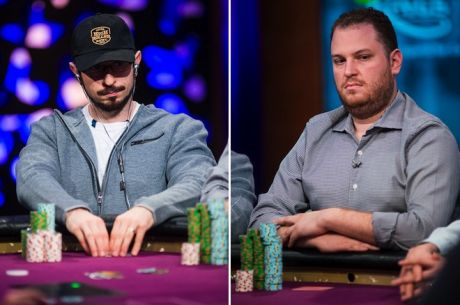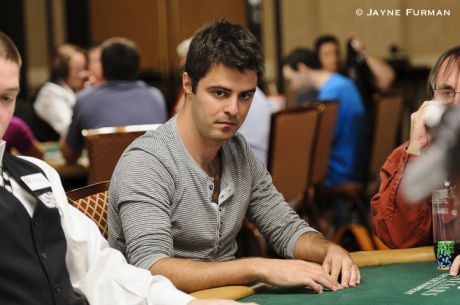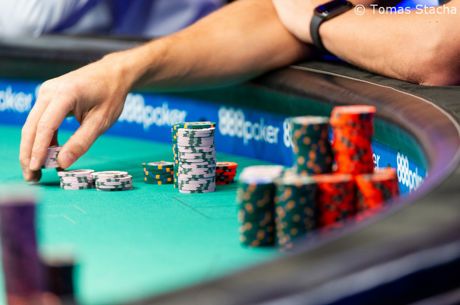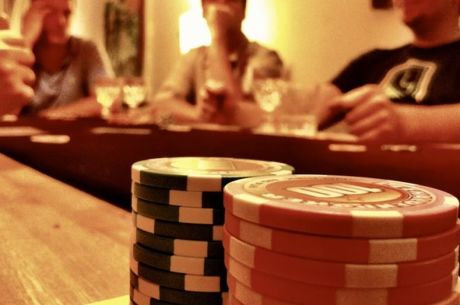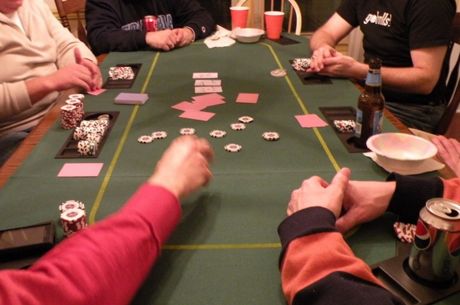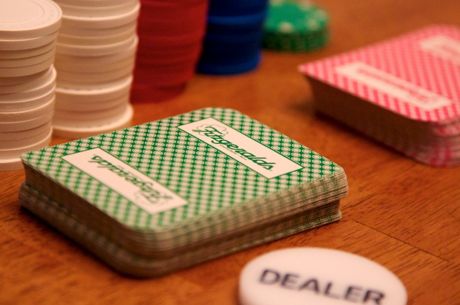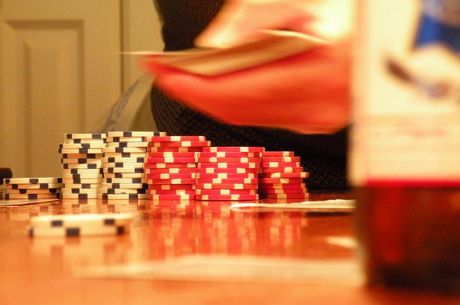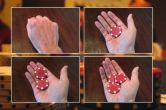Home Game Heroes: Strategy for Seven-Card Stud Hi-Low Declare
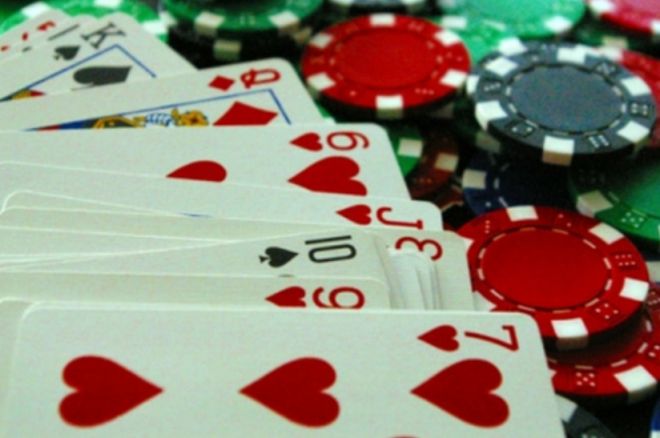
In my last column we looked at the strategic differences between ��cards speak�� games such as played in a casino and ��declare�� games such as you��ll find in home games. Specifically we discussed seven-card stud hi-low as our example of a split-pot game that can be played in either way.
In order to examine further the strategy involved in ��declare�� games in which players must choose whether to play for the high, for the low, or both, today��s column will examine decisions made during the play of a typical hand of seven-card stud hi-low declare.
Admittedly, this is an incomplete exercise, as an entire book could be written about just seven-card stud, hi-low declare. Perhaps, someday, someone shall write such a book. Until then, here is a hand to help you think through how to play the game correctly.
The Deal
It��s a $5/$10 dealer��s choice game in which seven-card stud hi-low declare has been called. In this game the dealer antes $1 per player and the high card showing must bring it in for either $1 or he may opt to bring it in for the small bet of $5.
Third Street
| Position | Hand |
|---|---|
| 1 | (A?)(Q?) 2? |
| 2 | (9?)(10?) 9? |
| 3 | (3?)(4?) 2? |
| 4 | (Q?)(K?) Q? |
| 5 | (10?)(J?) Q? |
| 6 | (3?)(6?) K? |
| 7 | (J?)(K?) 7? |
| 8 | (5?)(8?) 10? |
| 9 | (A?)(4?) A? |
The dealer is Seat 9, who has an ace showing that counts as a high card for the purpose of the initial bet.
(A?)(4?) A?: A pair of aces and a babe is an excellent hand in this game. No one will know which way is he is going in this round, and if he catches a bunch of low cards they may mistakenly go the wrong way against him. Thinking he will fool people into believing he is weak, he opts for the $1 rather than raising. Brings it in for $1.
(A?)(Q?) 2?: Having two out of three low cards is a borderline hand in a typical loose passive home game where raising during the first three cards is not common. In this instance, with two of the cards suited, one an ace, and only one other low card out that the player needs to make a good low, it is a reasonable, if somewhat loose call. Calls.
(9?)(10?) 9?: This is really a subpar starting hand, only worth playing for $1 and the shot of hitting trip nines on fourth street. Even then, I would typically fold it, since it will be an obvious high hand (if it hits) and could easily be up against a good low who is freerolling. In loose home games players typically play this type of hand �� and if you��re a good player you want them to, so you can exploit them by freerolling as I��ve described. Calls.
(3?)(4?) 2?: An excellent starting hand, made more so by the deuce that is out. There are two needed low cards also out (an ace and a seven) that diminish the value of it slightly. This player elects to see a fourth card cheaply. This play makes sense for deceptive purposes also, since a raise here would probably indicate three babes to perceptive opponents. Calls.
(Q?)(K?) Q?: This is a bad starting hand in this game, given the cards that are out especially. He should fold, since one of the two queens that gives him a playable hand is dead, as is one of the kings. Also, there is an ace out that could give his opponent a very exploitable overpair. He won��t know where he stands should that player raise him later, and he has only a thin draw to overtake him. He should fold, but he��s playing as if it were seven-card stud high, hoping to knock out other high hands. Raises to $5.
(10?)(J?) Q?: As pretty as this hand might appear, it should almost surely be folded. The odds of drawing to either a straight or a flush don��t warrant what is almost surely to be only half of the pot in this game, and the hand may even lose the high with low flush draws headed by an ace sometimes freerolling. Even so, this player has straight flush draw on his mind and can��t resist. Calls $5.
(3?)(6?) K?: This hand might make a hidden low, but four of the needed low cards are out, it is headed by the worst third card possible in the king, and the pot has been raised. This player sees nothing redeemable and does the right thing. Folds.
(J?)(K?) 7?: This is a very bad hand �� two high cards in the hole and a mediocre low card up. The right move is to fold, especially to a complete bet. Folds.
(5?)(8?) 10?: This, too, is a very bad hand �� one good low card and a bad low card with a ten. It is going nowhere. Folds.
(A?)(4?) A?: With this excellent hand he should now be raising to thin the field and get more money in a pot of which he has a good chance of winning at least half. He wants to make it expensive for any hand with three low cards to draw for the low. Raises to $10.
(A?)(Q?) 2?: Now having to call $9 to stay in, this player wisely gets out. Folds.
(9?)(10?) 9?: This player should get away from this loser, but doesn��t. Hope springs eternal. Calls.
(3?)(4?) 2?: This is still a great hand. Calls.
(Q?)(K?) Q?: Should surely fold, now that he has an indication that he is probably against a higher pair. He really has nothing if he is behind a pair of aces. Even so, since he raised, he wrongly feels duty-bound to see the next card. Calls.
(10?)(J?) Q?: Still in love with his three to a straight flush. He ends the action by continuing with the hand. Calls.
- Pot: $60
- 5 players remain
Fourth Street
| Position | Hand |
|---|---|
| 2 | (9?)(10?) 9?J? |
| 3 | (3?)(4?) 2?6? |
| 4 | (Q?)(K?) Q?4? |
| 5 | (10?)(J?) Q?6? |
| 9 | (A?)(4?) A?10? |
The highest hand showing acts first, and here it is Seat 9.
(A?)(4?) A?10?: Looking around the table, this player has what certainly appears to be the best high hand. Against standard loose passive home game players, he is much better off betting it for value than trying for something tricky like a check-raise. True, it gives away what he has to his opponents, but he is more interested in shooting for the $60 pot or getting those behind him to put in more money. He is alert to the possibility that the player with two low cards almost surely has four cards to a low (since a 2x was folded and a 6x is out). Even so, he wants to do his best to get rid of other hands with pairs who are drawing to trips or two pair. Bets $5.
(9?)(10?) 9?J?: This is an easy fold. He is almost surely behind two hands with higher pairs. The three-straight is not worth anything �� pursuing it would mean shooting for only half the pot, and with two of his primary straight cards staring him in the face (and a secondary one, the king, already folded). Even so, this guy can��t pass up the bargain of the $5 bet, deciding his time to fold will be reserved for fifth street when the bets double. Calls $5.
(3?)(4?) 2?6?: This player is thinking about raising with four cards to a low and with a gutshot straight draw. But he prudently reconsiders, realizing that he wants others to stay in a hand for which he expects to win half of the pot. He knows that if he makes it $10 his two remaining opponents will almost surely fold, having both caught what look like bad cards. Calls $5.
(Q?)(K?) Q?4?: He should almost surely be out, with what is now obviously an underpair. But he plays his high hand hoping to get two pair when the bets double. Calls $5.
(10?)(J?) Q?6?: Seeing no flush cards out, and not thinking about the fact that he is only drawing to half the pot, this player stays in hoping for magic. Calls $5.
- Pot: $85
- 5 players remain
Fifth Street
| Position | Hand |
|---|---|
| 2 | (9?)(10?) 9?J?8? |
| 3 | (3?)(4?) 2?6?K? |
| 4 | (Q?)(K?) Q?4?J? |
| 5 | (10?)(J?) Q?6?2? |
| 9 | (A?)(4?) A?10?4? |
Seat 9 continues to show the highest hand and so acts first.
(A?)(4?) A?10?4?: Hit two pair but it may look like a low to those who haven��t been paying attention to his betting, or who think he may be betting unconventionally. He��s glad to push the pot. Bets $10.
(9?)(10?) 9?J?8?: He picked up a straight draw, but one seven and two queens are gone. And he is only drawing to half the pot. He should have been out already, and he should certainly fold now. One-way draws can get expensive if his opponents decide to raise and reraise to make him pay. But he stays. Calls $10.
(3?)(4?) 2?6?K?: Though the king was the worst card in the deck, he figures to have low wrapped up with three cards to come, one of which will be concealed. He wants to make it expensive for the high hands, so no one backs into a decent low. He may also hit a gutshot. Now is the time to make the price of poker more expensive in this game, and he knows it. Raising is the right move. Raises to $20.
(Q?)(K?) Q?4?J?: This hand is getting steadily worse. Even so, this player doesn��t really understand hi-low declare at all, thinking the ace may be going for the low and that his queens may still be good for the high. He pays to find out otherwise. Calls $20.
(10?)(J?) Q?6?2?: With another bad card he finally gives up on this loser. Folds.
(A?)(4?) A?10?4?: He correctly reads that he is ahead for high, not believing the raising king represents trips since a king was folded already (and a two and six are both out for good measure). So he makes it harder for any draws to come in. Raises to $30.
(9?)(10?) 9?J?8?: Never say die with a straight draw! Calls $20 more.
(3?)(4?) 2?6?K?: Again, wanting to exploit what he believes will be a sure half-pot victory over those who are calling from behind and shooting for high, he caps it. Raises to $40.
(Q?)(K?) Q?4?J?: Finally cries uncle rather than put in another $20. Folds.
(A?)(4?) A?10?4?: He sees no reason to fold, though he��s a little nervous about the straight or flush draw to his left. Calls $10 more.
- Pot: $225
- 3 players remain
Sixth Street
| Position | Hand |
|---|---|
| 2 | (9?)(10?) 9?J?8?5? |
| 3 | (3?)(4?) 2?6?K?7? |
| 9 | (A?)(4?) A?10?4?9? |
Again, Seat 9 acts first.
(A?)(4?) A?10?4?9?: Perceives that he is still ahead and sees no reason to slow down. Bets $10.
(9?)(10?) 9?J?8?5?: He thinks that ��his�� seven jumped over him and unluckily hit his neighbor. He isn��t thinking that he shouldn��t be here in the first place. He sees the enormous pot of $225 and decides, incorrectly, that he has to see this to its conclusion. He should be thinking that he is not just going to have to pay $10 but $40 to see one more card, and that may have to pay another $40 to see a showdown where he may still lose the high even if he gets his straight. Calls $10.
(3?)(4?) 2?6?K?7?: He is now nearly certain that he will win low. As long as there is a third player still in, he wants to pump the pot. And he does. Raises to $20.
(A?)(4?) A?10?4?9?: Still judging himself to be ahead on high, he wants more money for his half of the pot. Raises to $30.
(9?)(10?) 9?J?8?5?: Just can��t say no. Calls for $20 more.
(3?)(4?) 2?6?K?7?: The more the merrier. He caps it. Raises to $40.
(A?)(4?) A?10?4?9?: Obviously still in. Calls for $10.
(9?)(10?) 9?J?8?5?: Calls for $10 more.
- Pot: $345
- 3 players remain
Seventh Street (The River)
| Position | Hand |
|---|---|
| 2 | (9?)(10?) 9?J?8?5? (5?) |
| 3 | (3?)(4?) 2?6?K?7? (A?) |
| 9 | (A?)(4?) A?10?4?9? (2?) |
The boards don��t change with the final down card, and Seat 9 is still highest.
(A?)(4?) A?10?4?9? (2?): Has a beatable hand, but figures the best way to keep the pot low is to bet rather than check, since his opponents may not be certain he hasn��t hit a wheel, a hidden flush, full house, or even Broadway. Bets $10.
(9?)(10?) 9?J?8?5? (5?): Can��t fold for $10 after hitting two pair and maybe sneaking into a high hand. Calls $10.
(3?)(4?) 2?6?K?7? (A?): With the second-best possible low, he chooses not to take the safe route of calling. Raises to $20.
(A?)(4?) A?10?4?9? (2?): He wants to minimize his risk and doesn��t think he can knock out a better hand with a raise. Calls for $10 more.
(3?)(4?) 2?6?K?7? (A?): Still hoping to sneak into high he calls. Calls for $10 more.
- Pot: $405
- 3 players reach showdown
The Declare
In this version of hi-low declare, there is no betting round after the declare (although as we discussed last time, that can be an option). Players conceal chips in their hands, with one chip for low, two chips for high, and three chips for high and low, with players who declare both ways having to win both (not tying either way) or their hand is disqualified.
(9?)(10?) 9?J?8?5? (5?) �� shows two chips for HIGH. Loses.
(3?)(4?) 2?6?K?7? (A?) �� shows one chip for LOW. Wins half for $202.
(A?)(4?) A?10?4?9? (2?) �� shows two chips for HIGH. Wins half for $203 (High gets extra $1).
The players declare as expected, with Seats 3 and 9 rewarded for playing their hands well and Seat 2 punished for his stubbornness.
Photo: ��Poker and chips,�� Viri G. Creative Commons Attribution-NoDerivs 2.0 Generic.
Ashley Adams has been playing poker for 50 years and writing about it since 2000. He is the author of hundreds of articles and two books, Winning 7-Card Stud (Kensington 2003) and Winning No-Limit Hold��em (Lighthouse 2012). He is also the host of poker radio show House of Cards. See www.houseofcardsradio.com for broadcast times, stations, and podcasts.
Want to stay atop all the latest in the poker world? If so, make sure to get PokerNews updates on your social media outlets. Follow us on Twitter and find us on both Facebook and Google+!

